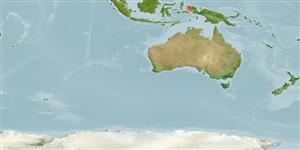Klassifizierung / Names
Namen | Synonyme | Catalog of Fishes(Gattung, Arten) | ITIS | CoL | WoRMS | Cloffa
>
Ovalentaria/misc (Various families in series Ovalentaria) >
Pseudochromidae (Dottybacks) > Pseudochrominae
Etymology: Pseudochromis: Greek, pseudes = false + Greek, chromis = a fish, perhaps a perch (Ref. 45335).
More on authors: Gill, Allen & Erdmann.
Environment: milieu / climate zone / depth range / distribution range
Ökologie
seewasser riff-verbunden; tiefenbereich 10 - 45 m (Ref. 90102). Tropical; 0°S - 3°S, 130°E - 133°E
Pacific Ocean: Indonesia (endemic to the Raja Ampat Islands).
Size / Gewicht / Alter
Maturity: Lm ? range ? - ? cm
Max length : 6.0 cm SL Männchen/unbestimmt; (Ref. 89094)
Kurzbeschreibung
Morphologie | Morphometrie
Rückenflossenstacheln (insgesamt): 3; Rückenflossenweichstrahlen (insgesamt): 24-25; Afterflossenstacheln 3; Afterflossenweichstrahlen: 14; Wirbelzahl: 26. This species differs from other pseudochromids in having the following set of characters: D III,24-25, usually III,24; A III,14; pelvic-fin rays I,5; anterior tip of palatine tooth patch directed medially behind posterolateral arm of vomerine tooth patch; upper part of body with dark (dark grey to black in life) longitudinal stripe, when present it is extending horizontally to or towards caudal-fin base; scales in lateral series 39-43; circumpeduncular scales 20-21, usually 20 (Ref. 89094).
This species is generally found around isolated, small coral and rock outcrops in both silty and clear water reef environments, usually in about 10-45 m depth (sometimes seen as deep as 60 m). Occurs solitarily or in small loose groups, is relatively curious and easy to photograph, though it invariably retreats into crevices or under coral heads when approached too closely (Ref. 89094).
Life cycle and mating behavior
Geschlechtsreife | Fortpflanzung | Ablaichen | Eier | Fecundity | Larven
Gill, A.C., G.R. Allen and M. Erdmann, 2012. Two new species of striped Pseudochromis from the Philippine Islands and Indonesia, with a redescription of P. colei (Perciformes: Pseudochromidae). Zootaxa 3165:25-38. (Ref. 89094)
IUCN Rote Liste Status (Ref. 130435)
Bedrohung für Menschen
Harmless
Nutzung durch Menschen
Mehr Information
NamenSynonymeMetabolismusRäuberÖkotoxikologieFortpflanzungGeschlechtsreifeAblaichenSpawning aggregationFecundityEierEientwicklung
Alter/GrößeWachstumLänge-GewichtLänge-LängeLängenhäufigkeitenMorphometrieMorphologieLarvenLarven Pop.Dyn.RekrutierungDichteBRUVS
ReferenzenAquakulturAquakultur ProfilZuchtlinienGenetikElectrophoresesVererbbarkeitKrankheitenVerarbeitungNutrientsMass conversion
PartnerBilderStamps, Coins Misc.LauteCiguateraGeschwindigkeitSchwimmstilKiemenoberflächeOtolithsGehirngrößeSehfähigkeit
Tools
Zusatzinformationen
Download XML
Internet Quellen
Estimates based on models
Preferred temperature (Ref.
123201): 27.4 - 29.1, mean 28.7 °C (based on 20 cells).
Phylogenetic diversity index (Ref.
82804): PD
50 = 0.5000 [Uniqueness, from 0.5 = low to 2.0 = high].
Bayesian length-weight: a=0.00490 (0.00187 - 0.01281), b=3.11 (2.88 - 3.34), in cm total length, based on LWR estimates for this (Sub)family-body shape (Ref.
93245).
Trophic level (Ref.
69278): 3.4 ±0.5 se; based on size and trophs of closest relatives
Fishing Vulnerability (Ref.
59153): Low vulnerability (10 of 100).
Nutrients (Ref.
124155): Calcium = 191 [93, 322] mg/100g; Iron = 0.899 [0.521, 1.544] mg/100g; Protein = 18.2 [17.1, 19.3] %; Omega3 = 0.116 [0.063, 0.212] g/100g; Selenium = 26.1 [11.5, 58.2] μg/100g; VitaminA = 159 [49, 510] μg/100g; Zinc = 2.32 [1.50, 3.36] mg/100g (wet weight);
